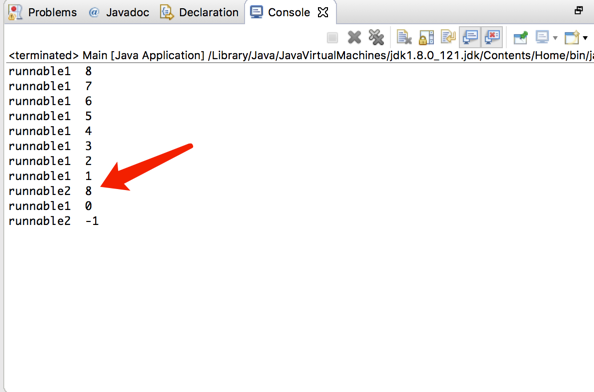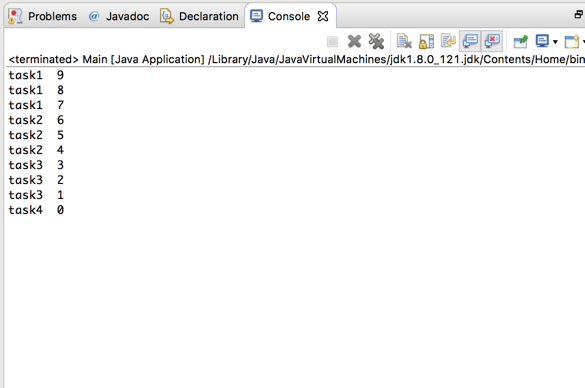自从java1.5以后,官网就推出了executor这样一个类,这个类,可以维护我们的大量线程在操作临界资源时的稳定性。
先上一段代码吧:
testrunnable.java
?
|
1
2
3
4
5
6
7
8
9
10
11
12
13
14
15
16
17
|
public class testrunnable implements runnable {
private string name;
public testrunnable(string name) {
this.name = name;
}
@override
public void run() {
while (true) {
if (main.surplus < 0)
return;
main.surplus--;
system.out.println(name + " " + main.surplus);
}
}
}
|
main入口
?
|
1
2
3
4
5
6
7
8
9
10
11
12
|
public static void main(string[] args) {
testrunnable runnable = new testrunnable("runnable1");
testrunnable runnable2 = new testrunnable("runnable2");
thread t1 = new thread(runnable);
thread t2 = new thread(runnable2);
t1.start();
t2.start();
}
|
这样,我们就看到了,数据肯定是乱了的,当然这个时候我们可以加上一个synchronized的关键字,但是这样也会出现点小问题的
下面我打算采用一种java内置的线程管理的机制,来解决这个问题,解决这个问题的思路大概就是,我们维护了一个线程池,当有请求操作的时候统统进入线程池,并且我们只开了一个线程,可以让请求顺序执行,顺序调用临界资源,就很安全了。
?
|
1
2
3
4
5
6
7
8
9
10
11
12
13
14
15
16
17
18
19
20
21
22
23
24
25
26
27
28
29
30
31
32
33
34
35
36
37
38
39
40
41
42
43
44
45
46
47
48
49
50
51
52
53
54
55
56
57
58
59
60
61
62
63
64
65
66
67
68
69
70
71
|
import java.util.concurrent.callable;
import java.util.concurrent.executionexception;
import java.util.concurrent.executorservice;
import java.util.concurrent.executors;
import java.util.concurrent.future;
public class main {
public static int surplus = 10;
private executorservice executor = executors.newsinglethreadexecutor();
void addtask(runnable runnable) {
executor.execute(runnable);
}
<v> v addtask(callable<v> callable) {
future<v> submit = executor.submit(callable);
try {
return submit.get();
} catch (interruptedexception e) {
system.out.println("interruptedexception" + e.tostring());
} catch (executionexception e) {
system.out.println("executionexception" + e.tostring());
}
return null;
}
public void testaddtask(string name) {
addtask(new runnable() {
@override
public void run() {
for (int i = 0; i < 3; i++) {
if (main.surplus <= 0)
return;
main.surplus--;
system.out.println(name + " " + main.surplus);
}
}
});
}
public void testaddtask2(string name) {
int count = addtask(new callable<integer>() {
@override
public integer call() throws exception {
for (int i = 0; i < 3; i++) {
if (main.surplus <= 0)
return 0;
main.surplus--;
system.out.println(name + " " + main.surplus);
}
return main.surplus;
}
});
}
public void close() {
executor.shutdown();
}
public static void main(string[] args) {
main main = new main();
main.testaddtask("task1");
main.testaddtask2("task2");
main.testaddtask("task3");
main.testaddtask2("task4");
main.close();
}
}
|
在这里,我们定义了两种方法,分别是addtask,具有泛型的addtask,这两种方法实现原理都是一样的,其中一个是有回调的,一个是没有回调的,就看项目需求了吧。
然后分别调用这两个方法咯,就可以看到结果是非常有序,且不会混乱的。
以上就是本文的全部内容,希望对大家的学习有所帮助,也希望大家多多支持快网idc。
原文链接:http://www.jianshu.com/p/ccdb616723ab
相关文章
猜你喜欢
- ASP.NET本地开发时常见的配置错误及解决方法? 2025-06-10
- ASP.NET自助建站系统的数据库备份与恢复操作指南 2025-06-10
- 个人网站服务器域名解析设置指南:从购买到绑定全流程 2025-06-10
- 个人网站搭建:如何挑选具有弹性扩展能力的服务器? 2025-06-10
- 个人服务器网站搭建:如何选择适合自己的建站程序或框架? 2025-06-10
TA的动态
- 2025-07-10 怎样使用阿里云的安全工具进行服务器漏洞扫描和修复?
- 2025-07-10 怎样使用命令行工具优化Linux云服务器的Ping性能?
- 2025-07-10 怎样使用Xshell连接华为云服务器,实现高效远程管理?
- 2025-07-10 怎样利用云服务器D盘搭建稳定、高效的网站托管环境?
- 2025-07-10 怎样使用阿里云的安全组功能来增强服务器防火墙的安全性?
快网idc优惠网
QQ交流群
您的支持,是我们最大的动力!
热门文章
-
2025-05-25 64
-
2025-06-05 22
-
2025-05-25 83
-
2025-05-29 80
-
2025-05-25 60
热门评论













